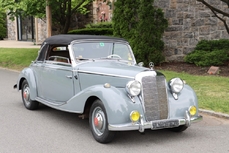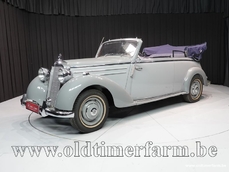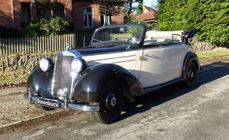Mercedes-Benz 170S Cabriolet 1951
General description :
Mercedes-Benz has been a manufacturing powerhouse for over a century, and during World War II, its factories were highly valuable targets for Allied bombers. Many of their manufacturing and design facilities were heavily damaged, but despite this, the company was quick to resume automobile production after the war. The first post-war cars were the W136 170 V sedans which traced their roots back to the late 1930’s. These bread-and-butter sedans served as solid, reliable transportation in the austere post-war years and became popular with taxi and delivery drivers. But as Europe recovered and production of the 170 V increased, so too did demand for more luxurious and special models. To meet this demand, the 170 S was introduced. The first special-class car to be built by Mercedes-Benz after the War; the 170 S had a more powerful engine than the 170 V, as well as improved front suspension, revised styling and a more luxurious and spacious cabin. Power came from an uprated version of the 1.7 liter inline four-cylinder engine, producing 53 horsepower and 82 ft-lbs or torque. The 170 S was offered as a handsome saloon, full four-seat Cabriolet B and sporty Cabriolet A. Open cars were meticulously hand-built at Mercedes’ Sindelfingen Carrosserie, where they were luxuriously trimmed with leather and wood. While Mercedes was still many years away from officially designating “S-Class” as its flagship range, many feel that the 170 S is its spiritual predecessor. With the 170 S, Mercedes-Benz had marked its return to the top of the luxury motorcar market.
This outstanding 1951 170 S is from the final year of production, one of just a handful sold that year with the highly desirable Cabriolet A coachwork by Sindelfingen. A gorgeous car from top to bottom, it has been treated to a concours-quality restoration with meticulous attention to detail. Copies of the original build sheets and documents show this car was ordered in July of 1951. Upon its completion, it was dispatched from the Sindelfingen Werk, bound for Zurich Switzerland. Swiss import documents dated March 28th 1952 show it was delivered to Herr Ernst Benz. Not long after, the Mercedes was purchased in Switzerland by an American Army officer, and it eventually made its way to the United States. In about the mid-1960s, it was purchased by Richard A. Carlson of Coatesville, Pennsylvania who kept it for approximately 20 years. The next owner was Mr. Walter Progner who purchased the car in 1984, and is the man who eventually embarked on a multi-year restoration to return this fine motor to its former glory.
These early post-war Mercedes-Benz automobiles are extremely difficult and costly to restore properly, and as such, we seldom see them given the treatment they deserve. Thankfully, Mr. Progner was a passionate enthusiast who lavished the little Mercedes with tremendous care. As the restoration commenced, the chassis and mechanicals were entrusted to Gerhardt Reinhard, proprietor of a small shop in Pennsylvania that specializes in classic Mercedes-Benz automobiles. Mr. Reinhard was himself an employee of the Sindelfingen Werk during the time this car was built – making it entirely possible he had a hand in its original construction and its restoration! Concurrently, the body and interior were restored over a three year period by Barry Stalnecker of Annville, PA, while the extensive brightwork was restored to concours standards by Martin’s of Philadelphia.
The results of the restoration speak for themselves. Paintwork has been restored to the original shade of maroon (DB 513), and is beautifully applied showing straight, clean reflections and glassy-smooth surfacing. As part of the restoration, the body was removed from the chassis, jigged and disassembled. These are notoriously difficult to align properly, and the restorers did an exemplary job refitting the panels. The rear-hinged doors fit very well, with even gaps and the signature solid-hewn feel that is unmistakable Mercedes-Benz. Fitment of the extensive chrome trim is excellent, and even upon close inspection, reveals virtually flawless finishing. Interesting details include the semaphore turn signals, and the flush fit tail lamps. Most 170s had bullet-type tail lights, but this being a late production example; it features the flush-mounted units that were carried over into the later 220 S and 300 S models.
Of course, the signature of the 170 S was the luxuriously trimmed interior. Again, using the build sheet as a reference, this car was restored using natural tan leather supplied by a German restoration specialist. The material is exquisite and unmarked, expertly fitted to the frames. The folding, occasional rear seats are also trimmed in the same high quality leather, as are the door cards and even the fascia of the dash. Caramel-colored carpets tie in beautifully with the natural leather, again very nicely executed, in excellent condition and in factory correct materials. Leaving no screw unturned, the restorers returned the wood, which adorned the dash, door caps and cockpit surround, to its original natural finish. Interior chrome fittings are beautiful, and the dash is equipped with its correct VDO instrumentation and a most wonderful, original Telefunken Radio. The fully-lined cabriolet top features large chrome landau bars and is trimmed in correct tan German Sonnendeck canvas.
The trunk is detailed with a correct spare wheel, original tool roll and jack as well as a 2 piece set of fitted luggage, held in situ with leather straps. Beneath the bonnet, the engine is well detailed, showing only the lightest signs of use, but remaining in very clean and tidy condition. Despite its modest horsepower and pre-war era roots, the engine is a strong and eager unit, delivering performance that is brisk and enjoyable. Road manners are excellent, as this car has received some recent servicing and sorting. The history is very well documented with copies of the rare original build sheet, early customs documents, and extensive restoration records. Original service manuals, parts books and instruction books are included as is an original dealer brochure and show records. Shown multiple times at the world famous AACA Eastern Fall Meet, best known as "Hershey", this fabulous car was awarded an AACA Senior award in 2009, and an AACA Preservation award in 2012. It has also been shown on the lawn of the prestigious Amelia Island Concours d’Elegance in 2013.
This superb Mercedes-Benz 170 S has been cherished by its previous owners, and the quality of the restoration speaks to its importance in the collector world. Just over 800 units of the 170 S Cab A were produced between 1948 and 1951, and this is one of the last of last Mercedes to be truly hand-built in the historic Sindelfingen works; a very special and highly desirable motorcar from Mercedes’ golden era.
https://hymanltd.com/vehicles/6509
1951 Mercedes-Benz 170S Cabriolet is listed sold on ClassicDigest in St. Louis by Mark Hyman for $169500.
Car Facts
Car type : Car Make : Mercedes-Benz Model : 170S Model Version : Cabriolet Engine size : 0.0 Model Year : 1951 Sub type : Convertible Location : Missouri
Sold
Seller Information
Sold
People who viewed this Mercedes-Benz 170S also viewed similar Mercedes-Benz listed at ClassicDigest
Other cars listed for sale by this dealer
About Mercedes-Benz
In the annals of automotive history, the journey of Mercedes-Benz is a tale that unfolds with the ingenuity of its founding pioneers. In the year 1886, Karl Benz crafted the Benz Patent Motorwagen, a creation that would go down in history as the world's inaugural automobile. Unbeknownst to him, this moment marked the genesis of what would evolve into the most illustrious premium car manufacturer globally. The financial underpinning of this pioneering venture, interestingly, was provided by Karl Benz's wife, Bertha Benz, demonstrating a remarkable partnership that would set the tone for Mercedes-Benz's legacy.A parallel narrative emerged not far away, as Daimler-Motoren-Gesellschaft, founded by Gottlieb Daimler and Wilhelm Maybach, entered the scene. In 1901, they unveiled their automobile under the now-famous moniker "Mercedes," meaning "godsend" in Spanish. This name was bestowed upon the car at the behest of Emil Jellinek's daughter, the distributor for Daimler-Motoren-Gesellschaft. The wheels of innovation were set in motion.
Fast forward to 1926, a pivotal year that witnessed the merger of Daimler with Benz & Cie., culminating in the birth of Daimler-Benz. The amalgamation saw the adoption of "Mercedes-Benz" as the distinguished trademark for their automobiles, fusing the legacies of two visionary entities into one.
Contrary to perceptions of conservatism, the trajectory of Daimler-Benz unfolds as a chronicle of industry firsts. From the introduction of the honeycomb radiator to the float carburetor, and the pioneering implementation of four-wheel brakes in 1924, Daimler-Benz consistently pushed the boundaries of automotive innovation. The diesel-powered Mercedes-Benz 260 D in 1936 marked the inception of diesel engines in passenger cars. The iconic Mercedes-Benz 300SL Gullwing made history as the first car with direct fuel injection, albeit the Gutbrod's tiny 2-stroke engine can claim precedence.
Safety innovations became a hallmark, with Béla Barényi's patented safety cell design in the "Ponton"-models in 1951, featuring front and rear crumple zones. The W116 450SEL 6.9 saw the introduction of the Anti-Lock Brake system (ABS), another pioneering safety feature. From the first production airbags and beyond, the legacy of "firsts" continued to be etched into the fabric of Daimler-Benz.
Over its centennial journey, Mercedes-Benz has not merely produced cars but has sculpted automotive icons. The SSKL, 710 SSK Trossi Roadster, 770K Grosser, 540K Spezial Roadster, 300SL Gullwing, w100 600 Pullman, w111 280SE 3.5 Flachkühler, w113 230SL Pagoda, w109 300 SEL 6.3, and w201 2.3-16 Cosworth stand testament to the brand's commitment to engineering excellence.
The roaring Silver Arrows, or "Silberpfeile," including the W 25, W 125, W154, W165, and W196, created a legacy of dominance on the racetrack. These machines were not merely cars; they were expressions of precision, speed, and an indomitable spirit that left their competitors in the dust.
As Mercedes-Benz marches into the future, it does so not just as an automaker but as a custodian of a legacy, a torchbearer of innovation, and a beacon of automotive excellence. The road ahead is sure to witness the continued fusion of cutting-edge technology, timeless design, and an unwavering commitment to setting new standards in the world of automobiles.
One luminary figure who left an indelible mark was Béla Barényi, often heralded as the "father of passive safety" for his pioneering work in safety engineering. His patented safety cell design, featuring front and rear crumple zones, became a hallmark of Mercedes-Benz's commitment to occupant safety, setting new standards that reverberated throughout the automotive world.
Moving through the chronicles, the collaborative genius of Wilhelm Maybach, alongside Gottlieb Daimler, laid the foundation for Daimler-Motoren-Gesellschaft. Their innovations not only birthed the first Mercedes but established a culture of relentless pursuit of technological excellence that remains integral to Mercedes-Benz's DNA.
In the post-merger era of 1926, Ferdinand Porsche emerged as a prominent figure within Mercedes-Benz. His work on the Mercedes-Benz S-Type, a supercharged race car, garnered acclaim and set the stage for a legacy that extended far beyond the marque. Porsche's impact would later extend to his eponymous company, but his influence at Mercedes-Benz during those formative years was pivotal.
As the 20th century progressed, the legendary Rudolf Uhlenhaut emerged as a key figure. Uhlenhaut, an accomplished engineer and the driving force behind the iconic Silver Arrows, played a crucial role in Mercedes-Benz's dominance in motorsports. His engineering prowess and attention to detail were instrumental in creating some of the most formidable racing cars of the era.
In the latter half of the century, figures like Bruno Sacco, the head of design at Mercedes-Benz from 1975 to 1999, left an indelible imprint on the brand's aesthetic identity. Sacco's design philosophy, characterized by clean lines and timeless elegance, shaped iconic models like the W126 S-Class and the W201 190E, solidifying Mercedes-Benz's reputation for luxury and sophistication.
The narrative would be incomplete without acknowledging the contributions of engineers like Hans Scherenberg, whose leadership in the 1970s ushered in a new era of technological innovation at Mercedes-Benz. Scherenberg's tenure saw the development of groundbreaking technologies, including the Anti-Lock Brake system (ABS) and the introduction of airbags in production cars.











